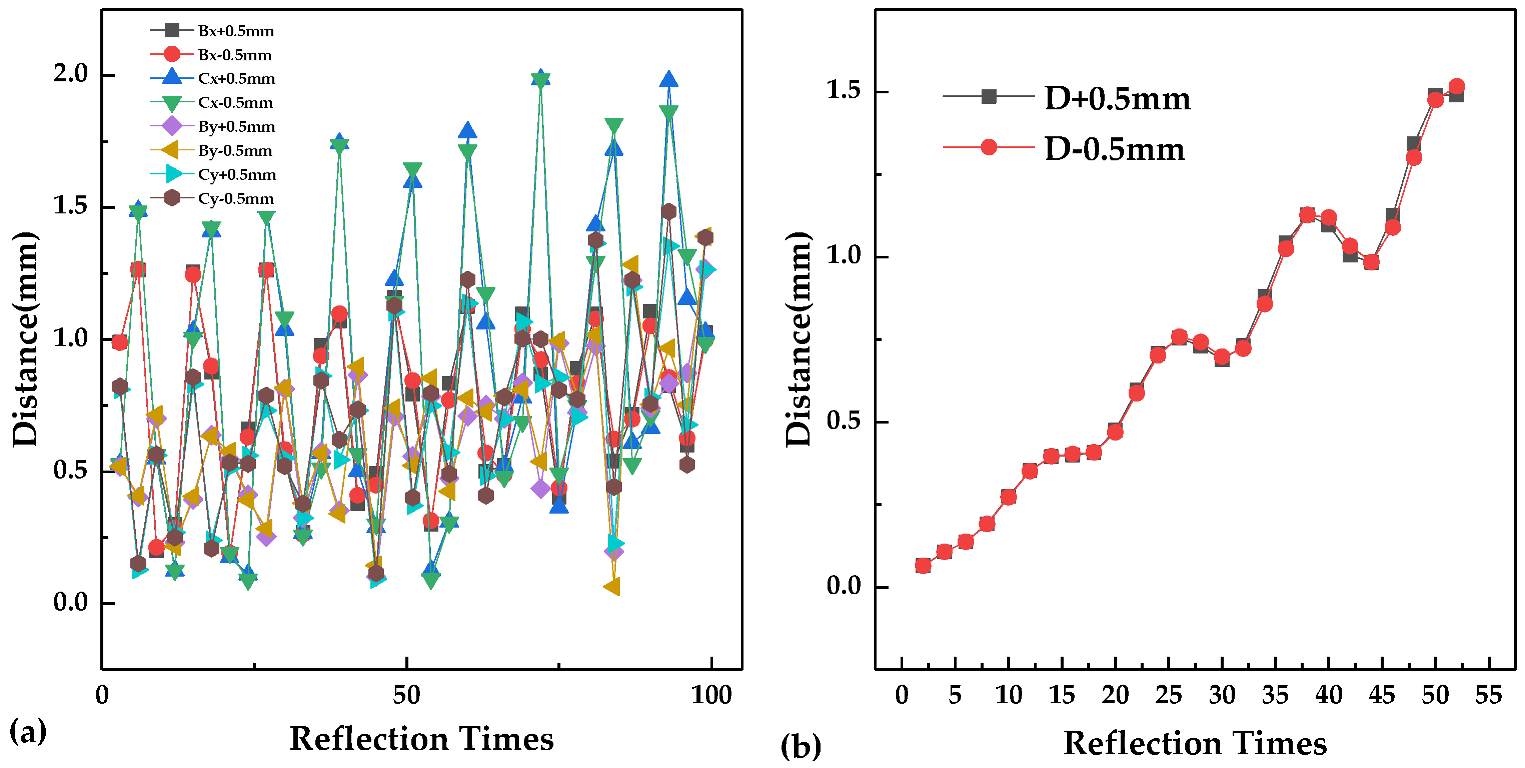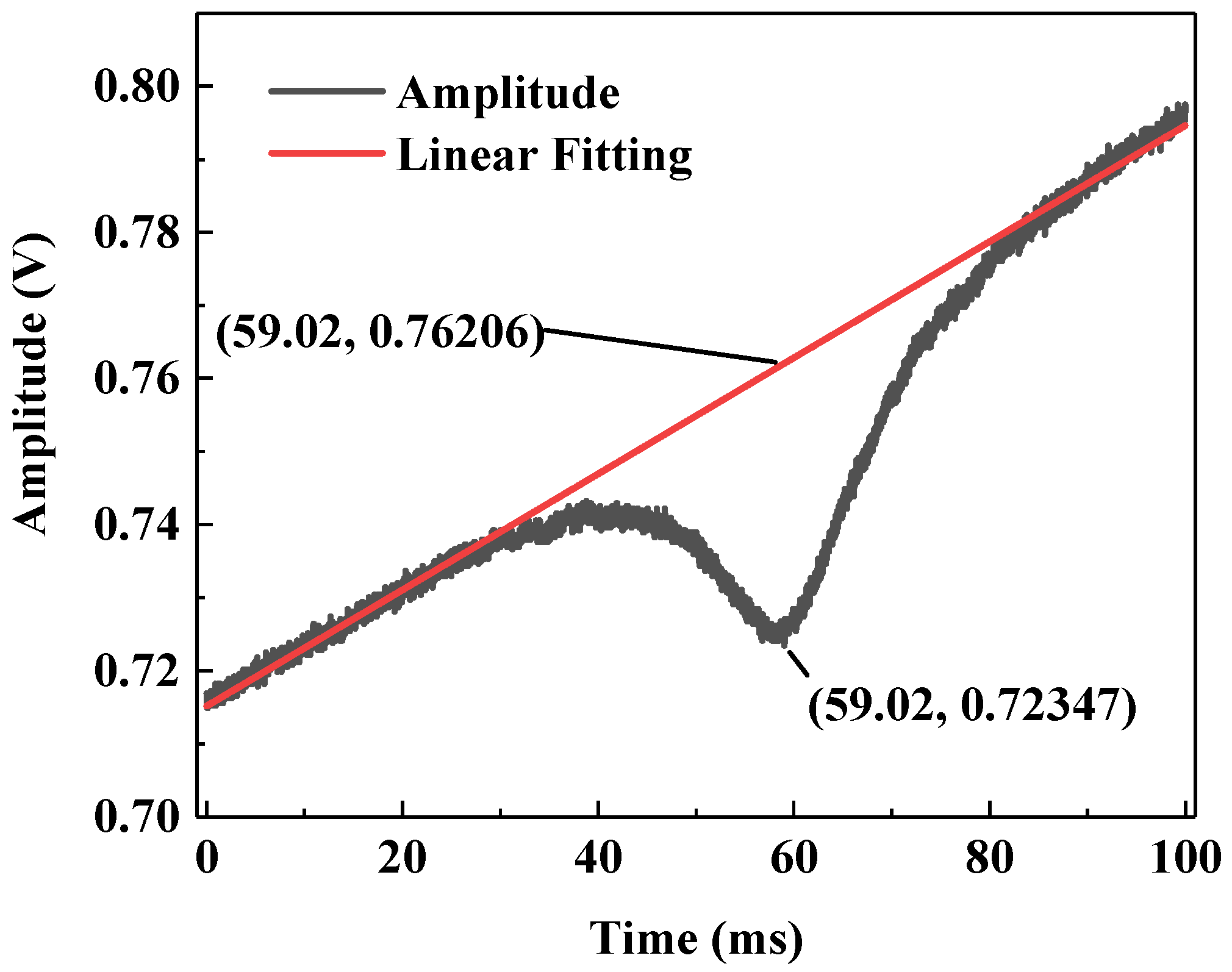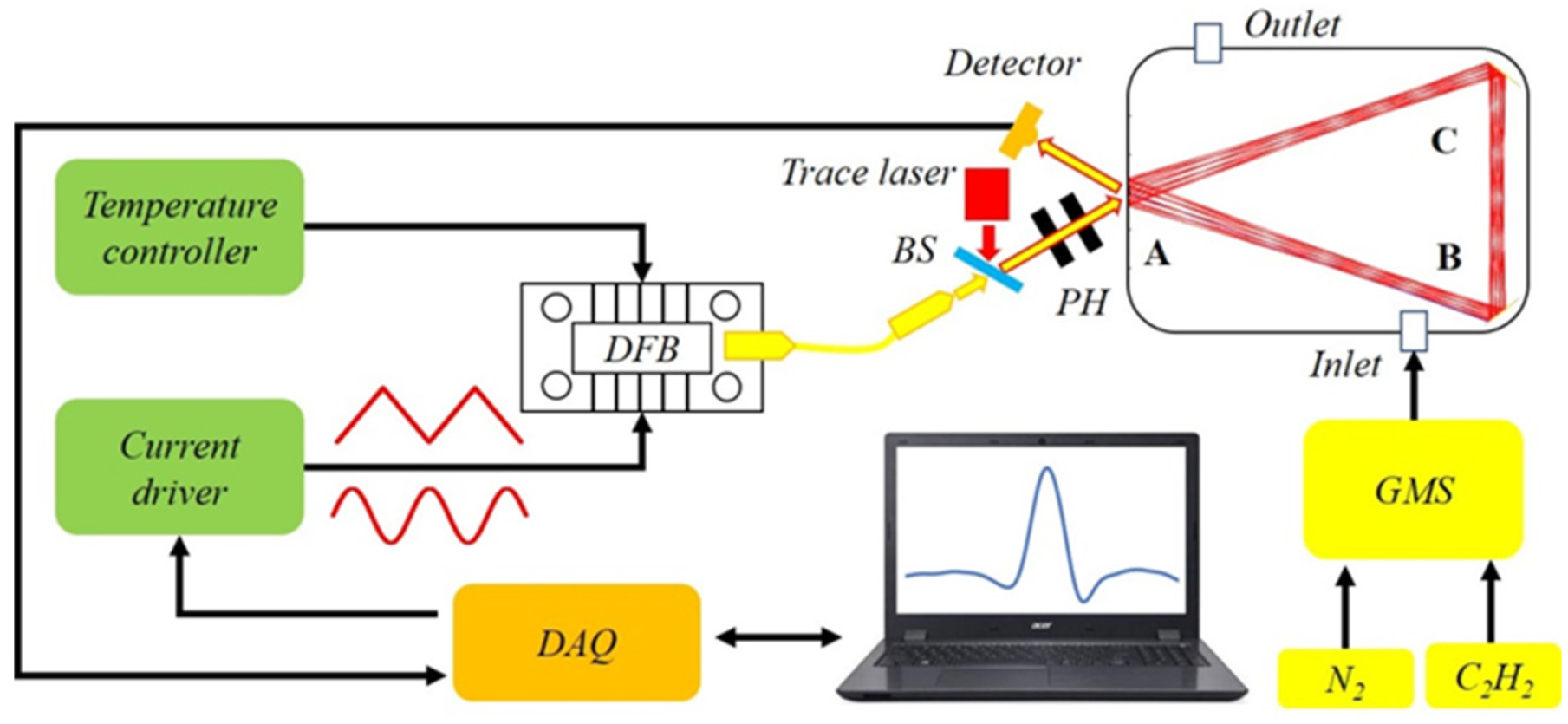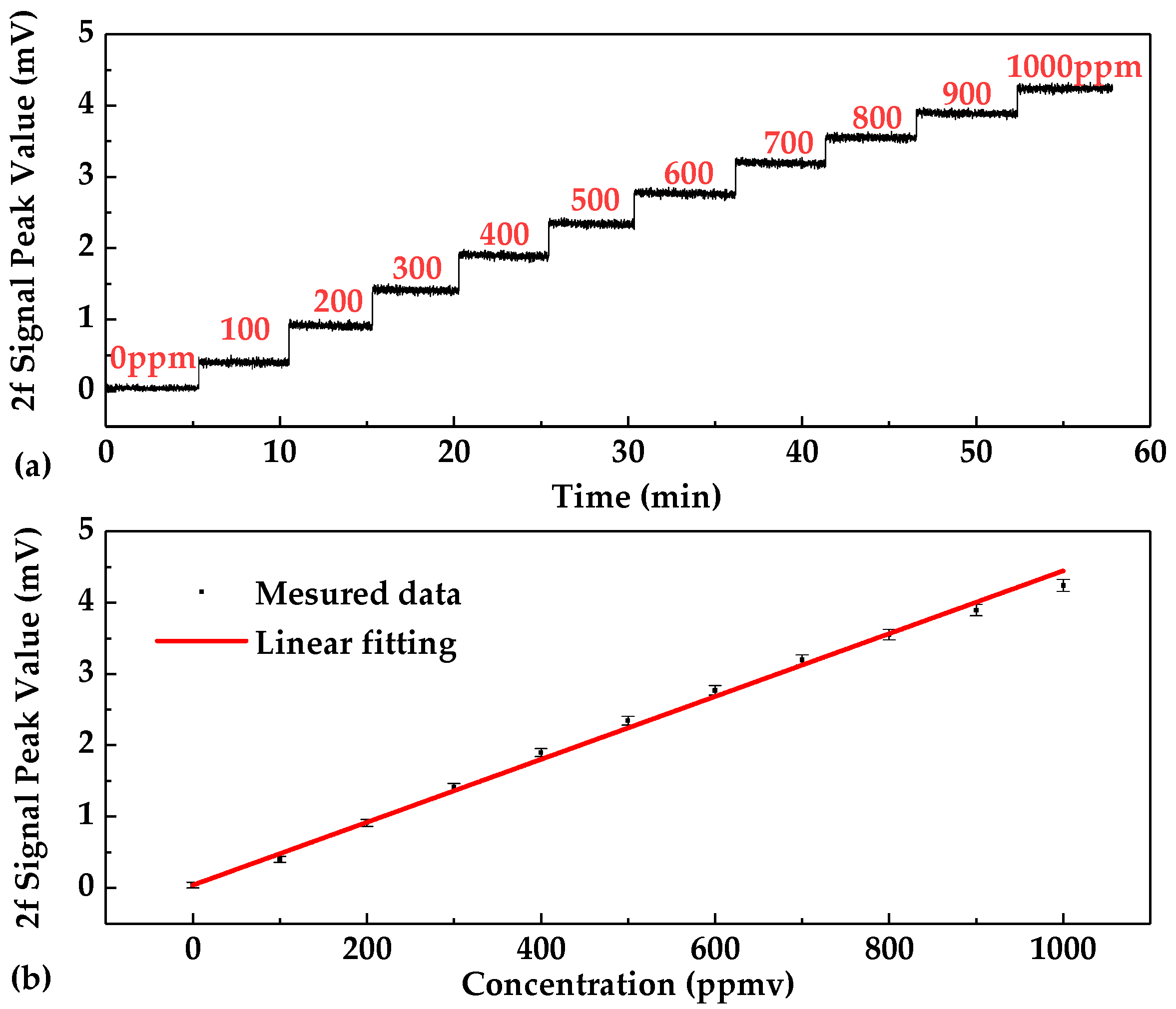Near-Infrared Tunable Laser Absorption Spectroscopic Acetylene Sensor System Using a Novel Three Mirror-Based, Dense Pattern Gas Cell
Abstract
:1. Introduction
2. Three Mirror-Based Gas Cell
2.1. Gas Cell Structure
2.2. Simulation
2.3. Mechanical Stability Analysis of the Gas Cell
2.4. Comparison with the Two Mirror-Based Herriott Cell
3. Gas Cell Development and Measurement
3.1. Mechanical Structure Design
3.2. Gas Cell Measurement
4. Performance of the C2H2 Sensor
4.1. Sensor Configuration
4.2. Calibration and Data Fitting
4.3. Sensor Stability
5. Conclusions
Author Contributions
Funding
Conflicts of Interest
References
- Zheng, K.Y.; Zheng, C.T.; Yao, D.; Liu, Z.D.; Li, J.H.; Zhang, Y.; Wang, Y.D.; Tittle, F.K. A near-infrared C2H2/CH4 dual-gas sensor system combining off-axis integrated-cavity output spectroscopy and frequency-division-multiplexing-based wavelength modulation spectroscopy. Analyst 2019, 144, 2003–2010. [Google Scholar] [CrossRef] [PubMed]
- Liu, N.W.; Deng, H.; He, T.B.; Liu, Y.; Zhang, L.; Li, J.S. Measurements of new absorption lines of acetylene at 1.53 μm using a tunable diode laser absorption spectrometer. Spectrochim. Acta Part A Mol. Biomol. Spectrosc. 2017, 186, 1–7. [Google Scholar] [CrossRef] [PubMed]
- Ma, G.M.; Zhao, S.J.; Jiang, J.; Song, H.T.; Li, C.R.; Luo, Y.T.; Wu, H. Tracing acetylene dissolved in transformer oil by tunable diode laser absorption spectrum. Sci. Rep. 2017, 7, 14961. [Google Scholar] [CrossRef] [PubMed] [Green Version]
- Kwak, D.; Lei, Y.; Maric, R. Ammonia gas sensors: A comprehensive review. Talanta 2019, 204, 713–730. [Google Scholar] [CrossRef] [PubMed]
- Alves, T.S.; Santos, J.S.; Fiorucci, A.R.; Arruda, G.J. A new simple electrochemical method for the determination of bisphenol a using bentonite as modifier. Mater. Sci. Eng. C Mater. Biol. Appl. 2019, 105, 110048. [Google Scholar] [CrossRef] [PubMed]
- Li, S.Z.; Dong, L.; Wu, H.P.; Yin, X.K.; Ma, W.G.; Zhang, L.; Yin, W.B.; Sampaolo, A.; Patimisco, P.; Spagnolo, V.; et al. Simultaneous multi-gas detection between 3 and 4 μm based on a 2.5-m multipass cell and a tunable fabry-perot filter detector. Spectrochim. Acta Part A Mol. Biomol. Spectrosc. 2019, 216, 154–160. [Google Scholar] [CrossRef] [PubMed]
- Shao, L.G.; Fang, B.; Zheng, F.; Qiu, X.B.; He, Q.X.; Wei, J.L.; Li, C.L.; Zhao, W.X. Simultaneous detection of atmospheric CO and CH4 based on TDLAS using a single 2.3 μm DFB laser. Spectrochim. Acta Part A Mol. Biomol. Spectrosc. 2019, 222, 117118. [Google Scholar] [CrossRef] [PubMed]
- Wang, B.; Lu, H.F.; Chen, C.; Chen, L.; Lian, H.Q.; Dai, T.X.; Chen, Y. Near-infrared C2H2 detection system based on single optical path time division multiplexing differential modulation technique and multi-reflection chamber. Appl. Sci. 2019, 9, 2637. [Google Scholar] [CrossRef] [Green Version]
- Li, X.; Fan, X.T.; He, Y.B.; Chen, B.; Yao, L.; Hu, M.; Kan, R.F. Development of a compact tunable diode laser absorption spectroscopy based system for continuous measurements of dissolved carbon dioxide in seawater. Rev. Sci. Instrum. 2019, 90, 065110. [Google Scholar] [CrossRef] [PubMed]
- Xie, Y.L.; Chang, J.; Chen, X.H.; Sun, J.C.; Zhang, Q.D.; Wang, F.P.; Zhang, Z.W.; Feng, Y.W. A DFB-LD internal temperature fluctuation analysis in a TDLAS system for gas detection. IEEE Photonics J. 2019, 11, 6801708. [Google Scholar] [CrossRef]
- Yang, C.G.; Mei, L.; Deng, H.; Xu, Z.Y.; Chen, B.; Kan, R.F. Wavelength modulation spectroscopy by employing the first harmonic phase angle method. Opt. Express 2019, 27, 12137–12146. [Google Scholar] [CrossRef] [PubMed]
- Li, C.L.; Shao, L.G.; Meng, H.Y.; Wei, J.L.; Qiu, X.B.; He, Q.S.; Ma, W.G.; Deng, L.H.; Chen, Y.Q. High-speed multi-pass tunable diode laser absorption spectrometer based on frequency-modulation spectroscopy. Opt. Express 2018, 26, 29330–29339. [Google Scholar] [CrossRef] [PubMed]
- Hayashi, D.; Nakai, J.; Minami, M.; Kamimoto, T.; Deguchi, Y. Simultaneous measurement of CH4 concentration and temperature distributions in a semiconductor process chamber. J. Phys. D Appl. Phys. 2019, 52, 485107. [Google Scholar] [CrossRef]
- Cui, R.Y.; Dong, L.; Wu, H.P.; Li, S.Z.; Yin, X.K.; Zhang, L.; Ma, W.G.; Yin, W.B.; Tittel, F.K. Calculation model of dense spot pattern multi-pass cells based on a spherical mirror aberration. Opt. Lett. 2019, 44, 1108–1111. [Google Scholar] [CrossRef] [PubMed] [Green Version]
- Yang, X.C.; Duan, L.C.; Zhang, H.W.; Lu, Y.; Wang, G.Y.; Yao, J.Q. Highly sensitive dual-wavelength fiber ring laser sensor for the low concentration gas detection. Sens. Actuator B Chem. 2019, 296, 126637. [Google Scholar] [CrossRef]
- Ma, Z.M.; Luo, Z.C.; Chang, T.Y.; Cheng, L.Y.; Wu, C.J.; Cui, H.L. Methane optical sensing system with polarization rotation gas cell. IEEE Sens. J. 2019, 19, 7415–7424. [Google Scholar]
- Yang, M.; Li, C.L.; Wei, J.L. A novel design of mutipass herriott type cell. Acta Sin. Quantum Opt. 2013, 19, 189–194. [Google Scholar]
- Mu, Y.J.; Chen, Y.; Hu, M.Y. Study and design of a kind of multi-pass white cell. Opt. Tech. 2014, 40, 345–348. [Google Scholar]
- Dong, M.; Zheng, C.T.; Yao, D.; Zhong, G.Q.; Miao, S.Z.; Ye, W.L.; Wang, Y.D.; Tittel, F.K. Double-range near-infrared acetylene detection using a dual spot-ring herriott cell (DSR-HC). Opt. Express 2018, 26, 12091. [Google Scholar] [CrossRef] [Green Version]
- Available online: http://www.spectraplot.com/absorption (accessed on 9 January 2019).
- Reid, J.; Labrie, D. Second-harmonic detection with tunable diode lasers-comparison of experiment and theory. Appl. Phys. B 1981, 26, 203–210. [Google Scholar] [CrossRef]












| Parameters | Bx | By | Cx | Cy | θB | θC | α | β |
|---|---|---|---|---|---|---|---|---|
| Value | 201mm | 63 mm | 201 mm | 63 mm | 53° | 53° | 19.5° | 2° |
| Parameters | D | f | x | y | z | α | β |
|---|---|---|---|---|---|---|---|
| Value | 248 mm | 100 mm | −199.7 mm | 9 mm | 0 mm | −2.1° | 2.5° |
| Module | Laser | Laser Current Driver and Temperature Controller | ||
|---|---|---|---|---|
| Wavenumber range | Model | Current range | Temperature | |
| Value/Type | 6520.4−6522.0 cm−1 | LDTC0520, Wavelength Electronics, USA | 38–96 mA | 23.8 °C |
| Module | Detector | Data acquisition card | ||
| Model | Model | Sampling rate | ||
| Value/Type | PDA10, Thorlabs, USA | USB-6211, National Instrument, USA | 100 kHz | |
© 2020 by the authors. Licensee MDPI, Basel, Switzerland. This article is an open access article distributed under the terms and conditions of the Creative Commons Attribution (CC BY) license (http://creativecommons.org/licenses/by/4.0/).
Share and Cite
Zhong, G.; Ma, Z.; Wang, J.; Zheng, C.; Zhang, Y.; Wang, Y.; Tittel, F.K. Near-Infrared Tunable Laser Absorption Spectroscopic Acetylene Sensor System Using a Novel Three Mirror-Based, Dense Pattern Gas Cell. Sensors 2020, 20, 1266. https://doi.org/10.3390/s20051266
Zhong G, Ma Z, Wang J, Zheng C, Zhang Y, Wang Y, Tittel FK. Near-Infrared Tunable Laser Absorption Spectroscopic Acetylene Sensor System Using a Novel Three Mirror-Based, Dense Pattern Gas Cell. Sensors. 2020; 20(5):1266. https://doi.org/10.3390/s20051266
Chicago/Turabian StyleZhong, Guoqiang, Zhuo Ma, Junbo Wang, Chuantao Zheng, Yu Zhang, Yiding Wang, and Frank K. Tittel. 2020. "Near-Infrared Tunable Laser Absorption Spectroscopic Acetylene Sensor System Using a Novel Three Mirror-Based, Dense Pattern Gas Cell" Sensors 20, no. 5: 1266. https://doi.org/10.3390/s20051266







